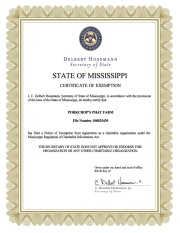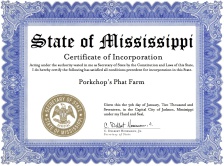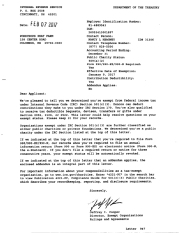Choking
Choking is interference with breathing caused by foreign material in, or compression on, the trachea (windpipe). In pigs, this most often happens because a piece of food, like an apple, is stuck in the esophagus and causes compression of the windpipe, which is located right next to the esophagus.
Signs of choking:
- slobbers
- vomiting
- standing with head extended with a worried expression
- inability or unwillingness to eat and drink
- difficulty in inhaling
- blue ears, nose, gums, tongue
- loss of consciousness
Frequently, coughing is confused with choking. Both cause the pet to forcefully exhale. With choking, the pet has difficulty inhaling. When coughing, the pet can inhale almost normally. Be careful
to distinguish the two: attempting to give first aid to a pet who is merely coughing can cause injury.
If you are in any doubt, have your pet evaluated by a veterinarian. To evaluate the throat, most pets will require sedation and some will require evaluation with a fiber-optic endoscope or X-rays to
look for foreign material.
If the Pet is Unconscious
Perform a Finger Sweep
Open your pet's mouth and do a finger sweep by placing your finger along the inside of the mouth, sliding it down toward the center of the throat over the base of the tongue, and gently "sweeping"
toward the center to remove any foreign material. Warning: there is a structure deep in the throat (the Adam's apple) that feels like a smooth bone. Do not attempt to pull it out!
If you can feel the object, but cannot clear it from the throat area
Use the handle end of a wooden spoon to push the object down into the esophagus so that the airway can be opened. Once the object is in the lower esophagus, breathing can resume and you can transport the pig to a veterinarian to have the object removed or pushed all the way into the stomach (where it can digest, or be removed more easily)
Begin Rescue Breathing
If air is not entering the lungs, slap the chest wall firmly or perform the Heimlich maneuver by putting the pet on his back, placing your hands over the abdomen near the bottom of his rib cage, and
gently but firmly thrusting toward the spine.
If this does not work, place the pig on its side, and place your hands over the chest, just behind the shoulders, and gently but firmly thrust your hands downward.
Perform a finger sweep and begin rescue breathing. Repeat until the foreign body is clear and the lungs can be inflated.
Transport to the veterinarian.
Rescue Breathing:
Make Certain the Animal is actually Unconscious
Talk to the pet first. Gently touch and attempt to awaken the pet. You could be seriously injured should you attempt to perform rescue breathing on a pig who was only sleeping heavily and was
startled awake.
Ensure an Open Airway
Extend the head and neck and pull the tongue forward.
Look in the mouth and remove any saliva or vomitus. If it is too dark to see into the mouth, sweep your finger deep into the mouth and into the throat to remove any vomit or foreign body. Be aware of
a hard, smooth, bone-like structure deep in the throat, which is likely to be the hyoid apparatus (Adam's apple). Serious injury could result if you pull on the hyoid apparatus.
Observe for Effective Breathing
Sometimes an animal will begin to breathe spontaneously when the head is put in the position discussed above (head and neck extended, tongue pulled forward). Watch for the rise and fall of the chest
while listening closely for sounds of breathing. If no breathing is evident in 10 seconds, begin rescue breathing.
Begin Rescue Breathing
Rescue breathing is performed by covering the pig’s nose with your mouth and forcefully blowing your breath into the lungs. In small pigs and piglets, you must hold the corners of the mouth tightly
closed while you force the air in.
In larger pigs, the tongue should be pulled forward and the mouth and lips held shut using both hands cupped around the muzzle. Force air into the lungs until you see the chest expand. Take your mouth away when the chest has fully expanded. The lungs will deflate without help. Air should be forced into the lungs until you see the chest expand.
Give 3 to 5 Full Breaths
After several breaths are given, stop for a few seconds to recheck for breathing and heart function. If the pig is still not breathing, continue rescue breathing 20 to 25 times per minute in piglets
or small pigs, or 12 to 20 times per minute in medium or large pigs. Push down on the stomach area every few seconds to help expel the air that may have blown into the stomach. If the stomach is
allowed to distend with air, the pressure will make the rescue breathing efforts less effective.
If Breathing is Shallow or Non-existent
If you find that breathing is either shallow or non-existent and the pet is still unconscious, continue rescue breathing 10 to 15 times per minute and transport the pet to the nearest veterinary
facility.
If the Pet is Conscious
Stay calm and try to keep the pet calm. If the pet is overheated, cool them with cool (not cold) water applied to their extremities (ears and feet) and belly, and transport them to the nearest
veterinarian. Perform a finger sweep only if it will not excite the pet. Do not perform a finger sweep if you believe your pet will bite you. It may be better to use a wooden or plastic spoon
to sweep the mouth to prevent injury to your hand.
Basic CPCR: Chest Compressions
After Ensuring an Open Airway, Check for a Pulse
If no pulse is detectable, begin chest compressions.
In Small pigs and piglets
Squeeze the chest using one or both hands around the chest. Depress the rib cage circumferentially.
Do this 100 to 150 times per minute.
In Large Pigs
Compress the chest wall with one or both hands, depending on the size of the dog and the size of the rescuer (whatever works best for you). If the pig is on her side, place your hand(s) on the side
of the chest wall where it is widest. If she is on her back, place your hand(s) on the breastbone. Depress the rib cage 1.5 to 4 inches, depending on the pig's size. Do this 80 to 120 times per
minute.
Coordinate Rescue Breathing and Chest Compressions
If possible, give breaths during the compressions. If it is not possible, give two breaths after every 12 compressions.
Continue CPR until
- You become exhausted and can't continue.
- You get the animal transported to a veterinary facility and professionals can take over.
- The pulse is palpable or heartbeats are felt and they are strong and regular.
In the vast majority of cases, artificial ventilations will continue to be required for a period of time, even though heart function has returned. This is due to the nervous system depression that occurs as a result of the arrest.
All resuscitated animals should be transported to a veterinary facility for further examination and care!
Reprinted with permission. ©Anita Jacobson, Just Mini Pigs FB Group






